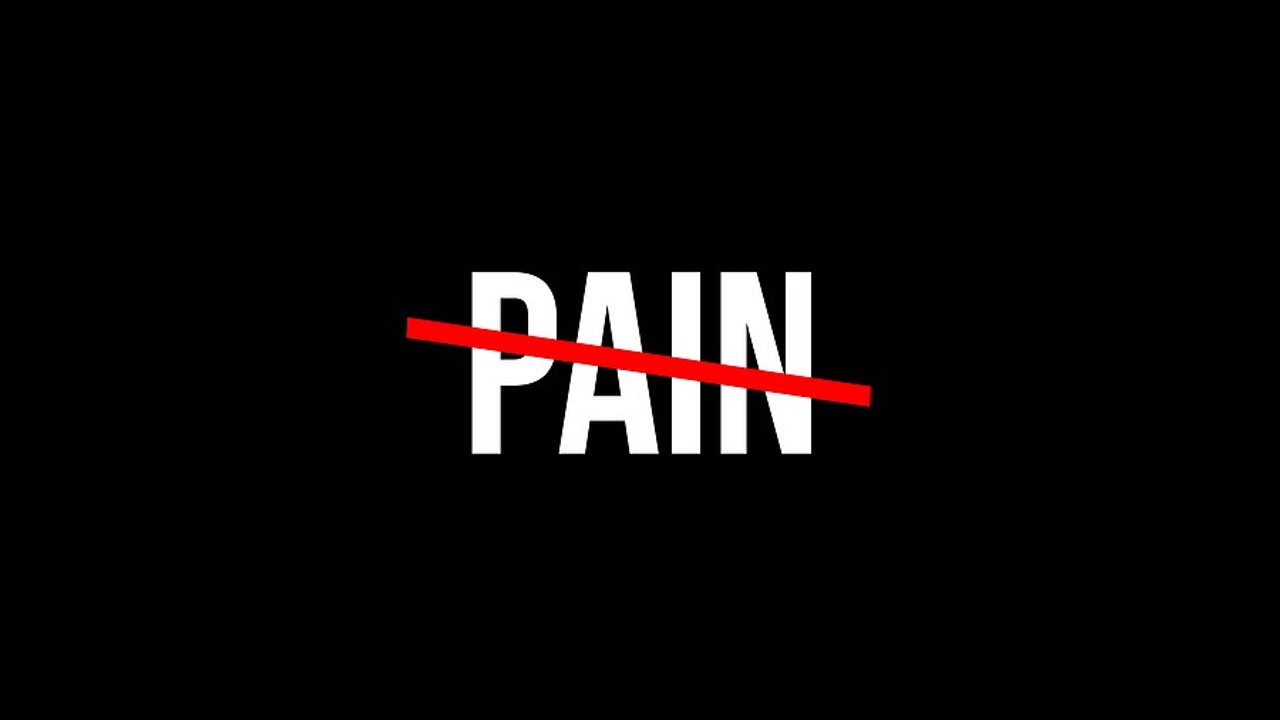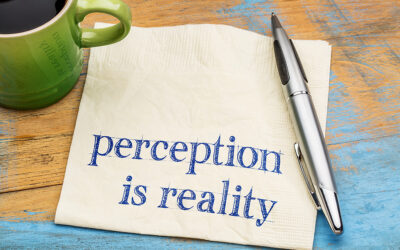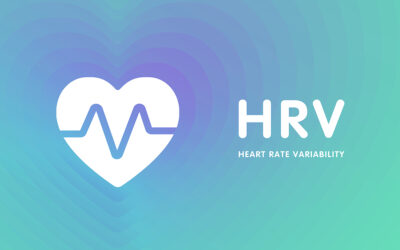Pain is:
“An unpleasant sensory and emotional experience associated with, or resembling that associated with, actual or potential tissue damage.”
This updated definition of pain was provided by The International Association for the Study of Pain (IASP) last summer (July 2020). Prior to this, the ISAP definition of pain had not been changed in over 40 years.
What I want to call your attention to in this definition is the use of the word “experience.” Before reading this definition, most of us would have probably categorized pain as a sensation: specifically, a negative sensation that causes suffering. Yet, the IASP classifies it as an experience. Why?
The message here is that pain acts on more than just the biological level. The last part of the definition further reinforces this idea: “associated with . . . actual or potential tissue damage.” This implies that you could feel pain even if you have healthy tissues. In other words, pain can exist without bodily injury. What?
I understand if you are a bit confused right now. What I’m saying doesn’t fit with what you know about the body. You might be wondering, How can I have pain without tissue damage? Body injury creates pain, right? It just doesn’t make sense. Well, actually, it does. However, that is not the discussion I want to have. Rather, I’d like to explore the disconnect between this definition of pain and your understanding of pain. The answer may lie in which health model you have adopted.
The Biomedical vs Biopsychosocial Models of Health
The Biomedical Model
The biomedical model had its beginnings over 400 years ago when Rene Descartes introduced his idea of mind-body dualism. His theory split the mind and body into separate substances. Descartes likened treatment of the body to a machine where the faulty part is worked on and repaired separately from the whole. Further, all illnesses (e.g., pain) in the body were attributed to biological factors. In this context, pain is described as a sensation and is the result of bodily impairment and pathology.
Recall that the IASP definition of pain above includes both sensory and emotional factors in describing pain: “An unpleasant sensory and emotional experience.” However, the biomedical model only recognizes the external “unpleasant sensory” stimulus as a cause of pain. The biomedical model says that the sole reason for pain is trauma to the tissues, bones or joints. In essence, it doesn’t take into account the “emotional” contribution to the pain experience.
Since this model has been guiding modern medicine for hundreds of years, it is likely that your knowledge of pain is based on this information. Mine was! As a young person, whenever I was injured, the medical provider and I focused our discussion solely on the site of the injury and pain.
Tissue Damage = Pain
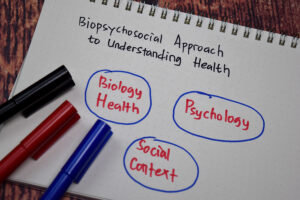
The Biopsychosocial Model
As you can see in the photo, the biopsychosocial model of health recognizes three areas: like the biomedical model, it recognizes biology/health, but it adds two more factors that influence health or illness or pain: psychology and social context. Thus, this model fits the new definition of pain because it includes both the “sensory” and “emotional” aspects of pain.
Psychological and Social factors that can impact pain include some, but not all, of the following:
- Beliefs
- Fears
- Threats
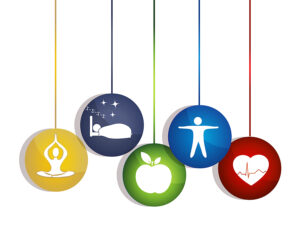
- Environment/Context
- Past Experiences
- Expectations
- Attitudes
- Culture
- Weight
- Stress Level
- Emotional State
- Sleep
- Nutrition
- And others.
Through the use of this model, we can understand how pain can occur in the absence of biological factors (e.g., tissue damage). In other words, this model says that pain can happen when your psychological state and social context, along with many other neurological factors, are numerous enough to trigger an episode of pain. This is especially pertinent to chronic pain.
We classify chronic pain as pain lasting over three months. Because tissues generally heal within this time frame, they should not be the source of ongoing pain. Instead, psychosocial elements that are impacting the nervous system often cause chronic pain. Adriaan Louw, PT, PhD, neuroscience researcher and author, says,
“In most cases people struggling with ongoing pain have more of a ‘pain problem’ than a ‘tissue problem.’”
Example: Ken’s Chronic Pain
As an example, I’d like to share the discussion I had with my husband Ken after reading him the first draft of this blog. I have italicized the contributing psychosocial factors in this scenario. Here’s what happened.
While mountain biking several months ago, Ken took a bad fall and landed on his chest and ribs—again. This is not the first time he’d done this. As a result, this area of his body has become a chronic source of pain for him. Because it has been over three months since his latest fall, his body should have healed by now. However, the memory of the pain still lives in his nervous system.
I explained that if he were to go for a ride on the same trail (environment) on the same bike with me (context), he might have some fear because of his past experience there. Then, his nervous system could sense a threat, thereby engaging the stress response. Finally, the combination of these factors, in addition to how well he slept the night before, what he had for breakfast (nutrition), along with his current emotional state, could be enough to reactivate his pain memory. This could affect him to the point that he actually feels physical pain while on that section of the trail.
In this case, his pain would not be a result of biological damage. He did not fall again and therefore does not have a tissue problem. Instead, this would be a pain problem. The state of his nervous system—meaning, how calm or revved up it was—when he went into the activity, as well as the quality and quantity of the psychosocial inputs his system received during the activity, would cause pain. In essence, the more on edge his nervous system, the less input that his body would need in order to trigger pain.
Beating Your Chronic Pain
Think back to your last interaction with a healthcare provider. What was the focus of the appointment? Did you examine psychosocial factors? Most likely, you paid little attention to these issues. Clearly, it is going to take time for the medical and alternative/complementary medicine fields to catch up to this latest science. After all, this new model—the biopsychosocial model—was only developed in 1977. And pain science is rapidly evolving. There is much for all of us to learn.
However, there is some good news! Research studies have found that if you simply learn about how pain works in the body, you can lessen your pain. In other words, understanding pain reduces pain! By reading this blog, you have already increased your pain science IQ above many in the general public. You might even know more than some people in the healthcare field. Want to learn even more and end your chronic pain for good? Join me in the pilot offering of a new group coaching program: PAIN FREE BODY.
Introducing PAIN FREE BODY, a group coaching program
Based on the biopsychosocial model
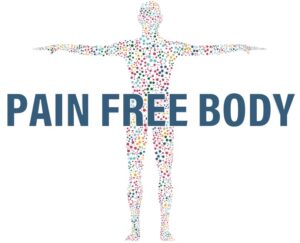 I am so excited to be launching this program. It has been in the works for over two years and has undergone major alterations. With your help, it’ll continue to evolve. I have created a webpage where you’ll find all of the details about the program: PAIN FREE BODY.
I am so excited to be launching this program. It has been in the works for over two years and has undergone major alterations. With your help, it’ll continue to evolve. I have created a webpage where you’ll find all of the details about the program: PAIN FREE BODY.
I have designed this group coaching program to help you with the psychosocial issues that may be holding you back from overcoming your chronic pain. Throughout the program, you will further your pain science knowledge, explore your mindset about pain, learn strategies to calm your nervous system, and gain skills to change the psychosocial factors that may be contributing to your continuous pain.
After much deliberation, I’ve decided to make this a small wellness coaching group. In essence, I have limited it to 10 participants. Why? Because the psychosocial issues surrounding chronic pain are sensitive and personal. Everyone’s pain experience is unique. Therefore, the setting for this program needed to match. I want to provide an environment with rich personal interactions that facilitates growth and transformation in the group members.
I’ve been studying neuroscience for several years, ever since I entered college many years ago. My Bachelor of Science degree is in Biological Psychology, which is today’s Neuroscience. In my book, Winning the Injury Game, I addressed the mental and emotional side of healing in the first section. I was pleasantly surprised at the positive responses I received on those chapters. Readers commented on how they really connected with the material. This reinforced to me the need for more resources, education, and support in this area. Read a section of the book in this blog: Your Brain Interprets Your Pain.
Duncan, Grant. Mind-Body Dualism and the Biopsychosocial Model of Pain: What Did Descartes Really Say?, The Journal of Medicine and Philosophy: A Forum for Bioethics and Philosophy of Medicine, Volume 25, Issue 4, 2000, Pages 485–513, https://doi.org/10.1076/0360-5310(200008)25:4;1-A;FT485
Louw, Adriaan. Why Do I Hurt? International Spine and Pain Institute: 2013.

